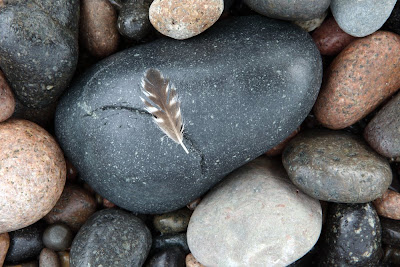But there’s a good reason to head west across from Loch Fyne to the open Atlantic ocean – you follow the Crinan canal, which was dug out two hundred years ago. The canal cuts out the sea trips around the lanky Mull peninsula, which not only meant a saving of a day or two of sailing, but also spared sailors of the more fearsome waters around the point of Mull.

Crinan canal cuts through the Mull of Kintyre
These days, it’s used mostly by leisure yachts, which use the narrow canal and its 15 locks to travel the nine miles across the mainland. If you’re into sailing, check out Scottish Canals for more info...it looks fun.
Pop into the small coastal harbour village of Crinan, where the yachts wait to use the canal. It’s a pretty area as well (although sunlight makes a huge difference – it’s been raining for a while now, and I’m starting to get some good weather).

The harbour at Crinan. Click for a full screen version.
But my main reason for travelling to this area is the huge number of bronze- and iron-age settlements by the distant ancestors of the Scottish people. There are more than 350 sites within a 6 mile radius of the town of Kilmartin (click to see on my Google Map).
There are standing stones, forts, stone engravings and other archaeological attractions which tell of a large, vibrant, war-faring community from the period 5000BC to 800AD. To compare, the wheel was only developed in Mesopotamia (modern Iraq) around 4000BC, and the first pyramid in Egypt was built around 2650BC. The beginning of organised society near Kilmartin precedes these by a thousand years. And the fact that there are so many sites, and that they are so old, is extra special.

The view out of my window at Dunchraigaig B&B looks onto the Ballymeanoch Stones, one of 350 ancient sites in the Kilmartin area, some dating back to 5000BC.
I’m no history nut, but it is interesting, and as with all ancient sites, there’s an unidentifiable, yet undeniable, aura of primordial time. I think it’s somehow reassuring that in our age, when most things have been identified, sliced open, examined, explained and published to everyone on the Internet, there are still places that remain a mystery to modern experts. Because much of Kilmartin’s sites are still baffling us.
Why are there carvings in the rocks? Were they for religious, astronomical or social reasons? Or were they simply for fun? And the standing stones? What to make of them? Stonehenge is still a mystery, and so are these sites.
I stayed at Dunchraigaig B&B , which is located in the middle of all the sites. Lyn and Cameron's B&B is right next to the site of the same name, and my room looked over the standing stones of Ballymeanoch. Lyn is an unofficial expert on the area, and her years of school teaching gives her a well-researched insight into the various spots.
For me, the most impressive was Dunadd Fort, which was the centre of the original Scottish Kindgom of Dalriada, around 500AD. It’s quite a lot younger than the original sites back in 5000BC, but it gives an indication of how long humans have lived and moved through the area. And quite clearly, the Dalriada chieftans knew how much the preceding tribes respected the territory, and perhaps chose this territory because of it. More remains of weapons have been found around Dunadd than any other site around the world during this period of time...

Dunadd Fort, the seat of the kingdom of Dalriad, the ancient ancestors of the Scottish. Click on the image for a full screen version.
The “fort” itself is not traditionally medieval (indeed, it pre-dates medieval times). Instead, it is a huge mound of rocks, about twenty metres high, which has been matted over now by soil and grass, although some rocks stick through, and are smoothed by centuries of footsteps. And most impressive of all is its location. It’s bang in the middle of a huge plain, between the hilly regions of Crinan and Kilmartin. You can see for miles, all the way around – 360 degrees.
I was alone on the evening I was there. I sat on the earth-throne of ancient Scottish chiefs, as the summer sun went down, and imagined what had gone before. A mound of earth, that’s all - but as powerful and impressive as the ornate seats of power at Buckingham Palace, the White House, Versailles and others...for me, perhaps more so.
Lyn also recommends the following things to do in the area.
1) A boat trip to Corryvreckan with Gemini Cruises.
2) The small Carnasserie Castle, just outside Kilmartin, built in 1572. You can walk to the top for nice views over the glen.
3) Visit Kilmartin House Museum , for a comprehensive insight into the ancient sites.
4) Go for lunch or dinner in the small fishing village of Tayvallich. I had a good baked cob with veggies at the Inn of the same name.
5) Or enjoy a cuppa at the Crinan Hotel , which has nice views over the western seaboard.

Carnasserie Castle, near Kilmartin.

The view from the top of Carnasserie Castle. Click for a full screen version.

A Celtic Cross near Tayvallich commemorating those who have died in the world wars.

My room at Dunchraigaig B&B near Kilmartin.

















































